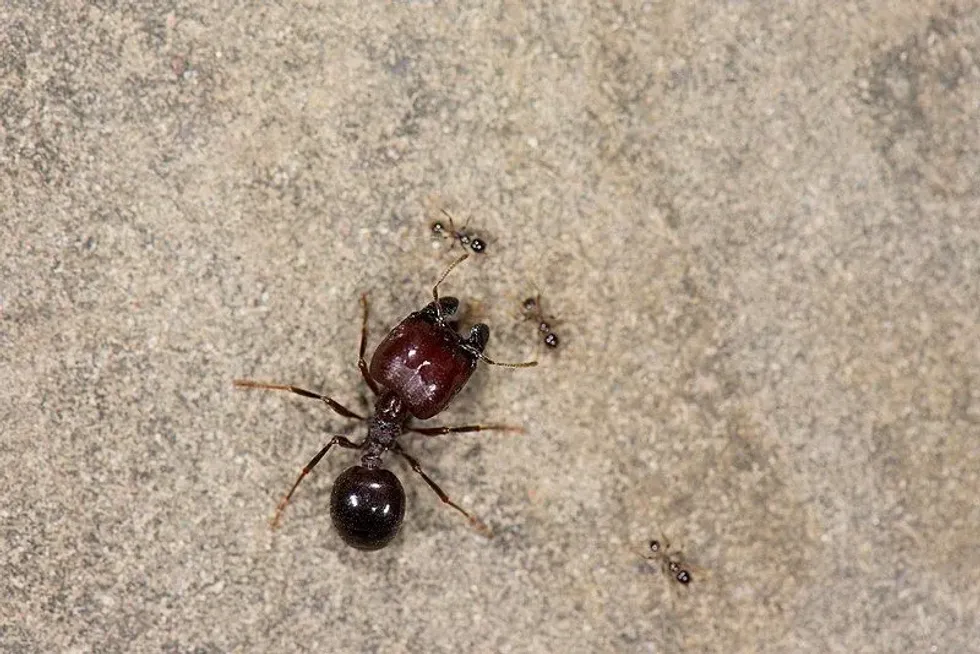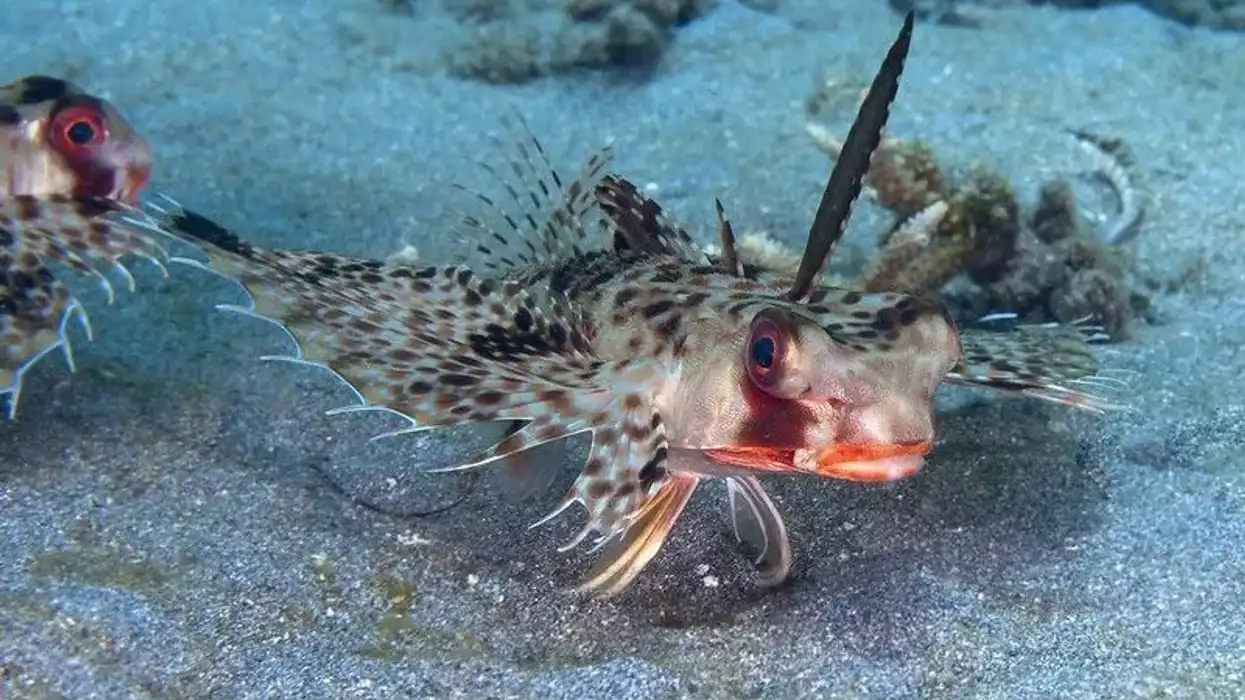The Asian marauder ant (Carebara diversa) is from the family Formicidae. Their population is widely distributed in India, Taiwan, and the Philippines. The habitat of this species consists of soil and rock crevices.
The ants go through a reproductive life cycle, which includes cream-colored eggs, grub-like larvae, and pupae. The appearance of a minor worker ant and a major worker ant differs and this is based on labor division.
The minor workers of this species are known to have yellowish or reddish-brown bodies and the antennal scapes are short and mandibles are known to have five teeth, whereas, a major worker is reddish-brown or blackish-brown in color. Its head is larger and square, unlike the minor ones who have a rectangular head.
The diet of this ant is known to be omnivorous and tends to feed on animals such as insects and also some nectarivorous materials. These ants are known to form large trails and work in the trails.
These ants are sometimes confused with the army ant species but there tends to be a number of differences between the two based on their nesting patterns and mating patterns. For instance, the nests of army ants are temporary and that of Asian marauder ants is permanent. These ants are known to be diurnal.
A queen is formed based on their diet and not genetics. Some studies state that ants are as old as dinosaurs.
It is very gripping to learn about the Asian marauder ant and if you like, read about black carpenter ant facts and velvet ant facts, too.
Asian Marauder Ant Interesting Facts
What type of animal is an Asian marauder ant?
An Asian marauder ant is a type of ant.
What class of animal does an Asian marauder ant belong to?
It is placed under the class of Insecta.
How many Asian marauder ants are there in the world?
No estimation for the global population of these ants is available.
Where does an Asian marauder ant live?
The Asian marauder ant is found in Asia and its range includes India, Taiwan, and the Philippines. It has also been found in Japan in the Okinawa Islands and Chicchi-Jima Island. It is not known if this ant is endemic to a certain place or not.
What is an Asian marauder ant's habitat?
The habitat of these ants is soil, and they are also found under rocks.
Who do Asian marauder ants live with?
Ants, in general, are known to live in large groups which are known as colonies.
How long does an Asian marauder ant live?
The life expectancy of this ant is not known.
How do they reproduce?
These ants go through a reproductive life cycle and this life cycle includes various stages. The eggs of the ant are known to be cream in color and small. The larvae of the ant do not have legs and have a grub-like appearance. Their pupae are also known to look similar.
What is their conservation status?
The conservation status of these ants is not known.
Asian Marauder Ant Fun Fact
What do Asian marauder ants look like?

Minor workers of this species are known to have reddish-brown to yellowish-brown bodies. The antennal scapes of the ants are known to be short and have been recorded to not cross the posterior edge of the head.
Their mandibles are known to have five teeth. The minor workers tend to have rectangular-shaped heads.
The major workers, on the other hand, tend to have blackish-brown or reddish-brown colored bodies. The heads are comparatively larger than and square in shape. The mandibles of the major workers are known to be triangular and large and known to have an acute crestal tooth.
The antennal scapes are half the size of the head and the eyes are small. Their appearance is based on the division of labor.
How cute are they?
The Asian marauder ant is not considered cute.
How do they communicate?
Ants are known to communicate through signals by legs and also use antennae to sense various types of chemicals.
How big is an Asian marauder ant?
The length of these ants is around 0.05-0.09 in (1.3-2.5 mm).
How fast can an Asian marauder ant run?
The exact speed of the Asian marauder ant is unknown.
How much does an Asian marauder ant weigh?
The weight of the Asian marauder ant is not available.
What are the male and female names of the species?
Fertile male ants are known as drones and fertile female ants are referred to as queens.
What would you call a baby Asian marauder ant?
The baby or the young ones have no specific names but could be called larvae.
What do they eat?
This ant species, Carebara diversa, is known to eat small animals like insects and also collect materials that are nectarivorous.
Are they poisonous?
This ant species is not poisonous.
Would they make a good pet?
Not a lot of information is available about these ants as pets, though we don't think they would make great pets.
Did you know...
Most of the species of ants form long trails. The Asian marauder ants (Carebara diversa) are known to use pheromones in order to maintain trails and if these trails are obstructed, there tends to be confusion and chaos.
Their long trails are sometimes covered with a roof that is constructed of soil particles.
The minors on the trail tend to hitch a ride on the majors in order to conserve their energy.
Some often tend to get confused between these ants and army ants but there are certain differences between the two.
The Asian marauder ants have permanent nests, whereas the army ants have temporary nests. The real army ant colonies tend to have only one queen and when the queen dies, the army ant workers either change colonies or join a new colony of workers, or the other members of the colonies also die.
The Carebara diversa species tend to mate during flight, whereas, the real army ants do not have wings and mates on the soil.
These ants are known to be diurnal.
There are conflicting records about this ant being aggressive. While some state that this ant is quite aggressive when it defends its nest and also when it hunts, some records state that it tends to avoid encounters and fights with ants.
Ants are known to not have lungs as their body is too small to accommodate a complex system of respiration.
Ants are also known to not have ears, but they are not deaf as they can feel vibrations.
Certain species of ants are known to be asexual like some Amazonian ants.
Ants tend to have two stomachs, one for their consumption and the other for holding food that is to be shared with other ants. This process is known as trophallaxis and helps the colony of ants to work efficiently.
Some species of ants tend to possess the ability to sustain in water as they can swim in their own ways.
Studies from some major universities have stated that ants are as old as dinosaurs as they were first recorded in the Cretaceous period that was around 130 million years ago.
In general, predators of ants include caterpillars, beetles, snakes, lizards, sparrows, starlings, snails, coyotes, bears, and jumping spiders.
It has been recorded that these ant species are difficult to keep in an ant farm colony and some of them have been observed in a home garden of hill-country in Sri Lanka.
What ants have supermajors?
Eight species of ants are known to have supermajors, which are also known as supersoldier ants. Supermajor is known to be the largest major category.
How does an ant become a queen?
It is believed that any female ant larva can become a queen. The ant becoming a queen is known to be not determined by genetics but by the diet of the female. Those who have a rich diet filled with protein become a queen, whereas, the ants who tend to receive less protein continue as workers.
Here at Kidadl, we have carefully created lots of interesting family-friendly animal facts for everyone to discover! Learn more about some other arthropods from our honey bee fun facts and hobo spider interesting facts pages.
You can even occupy yourself at home by coloring in one of our free printable insects for preschoolers coloring pages.
Main image by LiCheng Shih.
Second image by LiCheng Shih.










